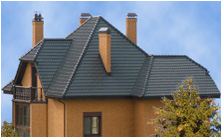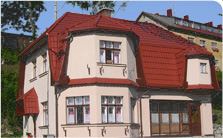Materials for waterproofing
The main objective of materials for waterproofing and vapor barrier - to maintain the desired mode of operation underlay insulation. They are assigned two functions. Firstly, to prevent the penetration of moisture in the insulation material, which is known to dramatically reduce its insulating properties, and in some cases leads to its progressive destruction. Secondly, as an integral part of the roof ventilation system, these materials are involved in preventing the accumulation of moisture in the insulation materials, making it easy way out of its vapors.
Waterproofing and steam insulating materials are materials such as film. Waterproofing the film should be used primarily for the device pitched roofs to the coatings do not form a continuous carpet (all kinds of tiles, metal roofing, slate). In fact, they are the second line of defense insulation layer from external moisture (snow, water droplets, condensation), which can penetrate a roof covering under extreme weather conditions (strong wind or slanting rain).
Vapor barrier film is required for the device as a flat and pitched roofs with any kinds of coverages. Their function - to protect the insulating layer against the penetration of water vapor in the interior areas as a result of human activity (cooking, washing, bathing, washing floors, etc.) and rising to the roof by means of diffusion and convection transport.
Until now the undisputed market leader in waterproofing and vapor barrier material is asphalt. Although The recent trend away from the use of glassine in favor of more expensive, but more high-quality materials is visible quite well. This is due to the fact that the asphalt does not meet modern requirements on the most important parameters, such as durability, strength characteristics, hydro and steam insulating properties, as well as environmental friendliness.
So we will not pay attention to asphalt and other materials on the basis of paperboard, and give information about modern materials such as film.
Separation of the underlay films on waterproofing and steam insulating rather arbitrary. Very often the vapor barrier film was successfully used for waterproofing underlay, and vice versa, a number of films intended for waterproofing, serve as a vapor tight barriers.
Therefore, we introduce for the convenience of several different classification and divide the film into the following three types: polyethylene film, polypropylene film and non-woven breathable membrane. The first type of film is used as a steam-and hydro-insulation film of the second type - mainly for waterproofing, but the third type of film - only as a waterproofing material.
Polyethylene film
Plastic films used for the underlay of hydro-and vapor barrier is always a special reinforced wire mesh or cloth, which gives the strength of the material.
Reinforced plastic films can be divided into two types - Punched and perforated.
Often, after the title of the film is a figure indicating the weight in grams per square meter.
It is believed that the perforated film used for waterproofing and punch - a vapor barrier. This is due to the fact that the perforated film due to the rare micro-holes have a higher water vapor permeability (S d = 1 ... 2 m) compared with the unperforated material (S d = 40 ... 80 m). Although in this case, water vapor permeability of perforated films is much less necessary.
Therefore, the advantage of perforated film before unperforated material when used as a waterproofing underlay is not very much. And in both cases required ventilation gap above the insulation. In addition, perforated film, as the unilateral application of the material, which pose some inconvenience in the work, in particular related to the formation of large amounts of waste.
Therefore, builders often refuse to apertured films, using as a waterproofing layer punch.
It is worth mentioning that in addition to conventional reinforced polyethylene films as a vapor barrier using special reinforced plastic materials, the inner side laminated with aluminum foil (film with reflective layer):
Steam insulating properties of such films is too high for rooms with normal temperature and humidity conditions (S d = 200 m). However, such films are indispensable for a vapor barrier coatings in hot or very humid areas such as baths, kitchens, saunas, pools, etc.
With regard to Western countries, there have long been limited to the use of polyethylene films as a vapor tight barriers. For the purpose of waterproofing using them, mostly just in the cold attic roofs. For waterproofing of warm roofs more often use more sophisticated films of polypropylene and nonwoven breathable membrane.
Polypropylene film
The advantages of reinforced polypropylene films are significantly higher (compared to films made of polyethylene) strength - about 10 kPa, as well as high resistance to ultraviolet radiation. Because of this polypropylene film with the necessary skills for the 12 months to protect building structures against snow and rain during the installation of roofing.
Polypropylene films are known in the Russian market for a long time, due to the fact that since the early 90-ies it imported from Finland, together with other components as "Additionally gathered" stuff to the roof of metal.
The use of warm roofs showed that recourse to the insulation surface waterproofing films (such as polyethylene and polypropylene) are often formed by condensation, which violates the temperature-humidity regime of the roof. To avoid this, one of the sides of reinforced polypropylene films were <knurl> Special antikondensatny layer of viscose rayon and cellulose. Antikondensatny layer can absorb and retain moisture, and its absorption capacity is so great that in critical conditions, it is able to absorb the entire way, moisture, while preventing the formation of droplets. After condensation conditions disappear antikondensatny layer dries quickly in the air stream.
It is obvious that antikondensatnye films have the unilateral use: a glossy surface up and down rough antikondensatnym layer. Between the insulation and the film is mandatory ventilation gap.
Due to the fact that this material has a high degree paronepronitsaemosti (S d = 50 ... 100 m), it is often used not only as a waterproofing, but also a vapor barrier.
Currently, in developed countries polypropylene film with both antikondensatnym layer, and without it the most widely distributed. The reason for this is their reasonable price and, as already mentioned, good strength characteristics.
The diffusion (breathable) membrane
Membranes are usually called 'breathable' films, ie film, providing protection against the penetration of atmospheric moisture remaining at the same time, almost transparent to exit from the inside of water vapor. High water vapor permeability (Sd <0,05 m) is achieved thanks to the special microstructure of the membranes, which are non-woven fabrics of synthetic fibers.
Membranes are due to the appearance of a sharp tightening of rules on teplosberezheniya building structures in Western countries. Today, in connection with the adoption of similar rules on teplosberezheniya in our country (SNIP II-3-79 * 'Building Heat Engineering') 'breathable' membranes have been widely used in our country.
The undeniable advantage of 'breathing' membranes is that they only allow the best use for the insulation of the space between the rafters. 'Breathing' of the membrane in contrast to all other kinds of films are placed directly on the insulating material, and therefore their use eliminates the ventilation gap that 'eats' up to 50% of the space intended for warming the roof.
For example, if the height of the rafters in the cross section of 150 mm, applying the 'not breathing' films, the thickness of insulation, which can be placed between the rafters, about 80 mm. According to modern requirements is almost two times smaller than normal (150 mm - 80 mm = 70 mm - which is the minimum ventilation gap (including at least 20 mm on the 'sag' of the film), which should be left to the airing of the heater). The use of 'breathable' membrane creates extra space for insulation, allowing the pack insulation thickness equal to the height of the rafters (in this example, 150 mm), which usually meets modern standards for teplosberezheniya.
'Breathing' of the membrane is particularly widely used in the construction of the attic. Their use is optimal for conversion into a cold attic attic room, without replacing the existing truss construction.
In our market there are several types of underlay 'breathable' membranes. Some of them:
• TYVEK Soft - DuPont (Luxembourg);
• YUTAVEK - JUTA (Czech Republic);
• DIFOROLL - BRAAS (Germany).
DIFOROLL and YUTAVEK - the unilateral application of the membrane, ie pack can only be defined down. Tyvek (Tyvek) - the membrane of bilateral, ie, it is set on a heater is admissible by either party.
These membranes have only one drawback - the higher price. True, the price difference between a "breathable" membrane and other types of films is "a drop in the ocean" compared to the cost of the entire roof and a fortiori, in comparison with the overall cost of the building.
Source: know-house.ru





